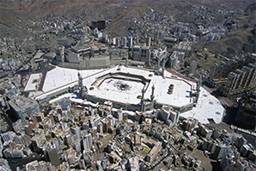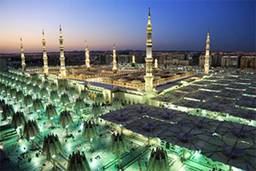Sacred Cities; Mecca, Medina, & Jerusalem (part 1 of 2)
Description: The importance of the sacred cities and why they hold a special place in the hearts of all Muslims.
By Aisha Stacey (© 2015 NewMuslims.com)
Published on 01 Jun 2015 - Last modified on 14 Jun 2015
Printed: 387 - Emailed: 0 - Viewed: 38,717 (daily average: 10)
Objective
·To understand why the three sacred cities are important.
Arabic Terms
·Masjid - the Arabic term for mosque.
·Sahabah - the plural form of “Sahabi,” which translates to Companions. A sahabi, as the word is commonly used today, is someone who saw Prophet Muhammad, believed in him and died as a Muslim.
·Kabah - The cube-shaped structure located in the city of Mecca. It serves as a focal point towards which all Muslims face when praying.
·Hajj - A pilgrimage to Mecca where the pilgrim performs a set of rituals. The Hajj is one of the five pillars of Islam, which every adult Muslim must undertake at least once in their life if they can afford it and are physically able.
·Qiblah - The direction one faces during the formal prayers.
 One of the sahabah once asked Prophet Muhammad
which was the first masjid built on earth. He replied, “The Sacred Mosque
in Mecca”. “Which was next?” the sahabi asked and the Prophet replied “Al-Aqsa
Mosque in Jerusalem”.[1]
One of the sahabah once asked Prophet Muhammad
which was the first masjid built on earth. He replied, “The Sacred Mosque
in Mecca”. “Which was next?” the sahabi asked and the Prophet replied “Al-Aqsa
Mosque in Jerusalem”.[1]
Prophet Muhammad advised his followers not to prepare for a religious journey except to three mosques.[2]
These three mosques are the three holiest sites in Islam and are situated in three sacred cities, Mecca, Medina and Jerusalem. All three cities are in the Middle East, two in present day Saudi Arabia and the other in the Holy Land, now known as either Palestine or Israel. In two lessons we will look closely at the significance of the three cities and discuss what they mean to Muslims around the globe.
Mecca
Mecca is home to the largest masjid in the world, Masjid Al-Haraam (The Sacred Mosque). It surrounds the Kabah, a cube shaped structure that Muslims believe is the world’s first house of worship. In the 21st century the masjid has a large outdoor terrace with white marble floors that reflect the bright light during the day and are floodlit at night. It is a huge space that allows for the influx of up to 4 million people in the Hajj season. It is a space that is always awake and where people from all over the globe congregate to spend their days and nights in worship and contemplation. Mecca nowadays is a far cry from its humble beginnings.
The area in which Mecca stands has been the subjects of stories stretching back to the very beginning of time. Both the Quran and the Bible mention Mecca’s earlier name of Becca as a place of worship. “…Blessed are those whose strength is in You who have set their hearts on pilgrimage. As they pass through the valley of Becca, they make it a place of springs…”[3]
“Verily the first house of worship appointed for mankind was at Becca…” (Quran 3:96)
The first Muslims prayed towards MasjidAl-Aqsa in Jerusalem. While in exile in Medina Prophet Muhammad received a revelation from God instructing him to turn towards the Kabah. Thus it became the qibla for Muslims throughout the world. The historians and scholars of Islam have differed on who built the Kabah. Some say that it was built by the angels. Others say the father of humankind, Adam built the Kabah but over many centuries it fell into disrepair only to be rebuilt by Prophet Ibrahim and his son Ishmael. All agree that the Kabah was either built or rebuilt by Prophet Ibrahim.
“And remember when Ibrahim and his son were raising the foundations of the House (the Kabah at Mecca), (saying), ‘Our Lord! Accept this service from us. Verily, You are the All-Hearer, the All-Knower’” (Quran 2:127)
Prophet Muhammad was born in the city of Mecca in 570 BCE. At that time Mecca was an oasis on the trade routes between Yemen and the Mediterranean Sea. There is historical evidence indicating that goods from all over the known world flowed through the markets of Mecca. And pilgrims used to come to visit the Kabah. At that historical point in time, it was filled with statues and idols.
Each year pilgrims travelled to Mecca and Prophet Muhammad’s tribe, the Quraish[4], made a very good living by trading with the pilgrims. Muhammad’s prophethood put their very lucrative livelihoods into jeopardy and this was one of a complex myriad of reasons why they wrought havoc upon the Muslims and eventually drove them from the city.
Prophet Muhammad once said of Mecca, “By Allah, you are the best and the dearest of all lands of Allah to Him. Had I not been driven out of you, I would have never left you.”[5] And, he once observed, “Allah, not the people, has made Mecca a sanctuary; therefore, any person who believes in Allah and the Last Day should neither shed blood in it nor cut down its trees.”[6]
When Prophet Muhammad returned to Mecca he took control of the city with great diplomacy, and with boundless mercy towards its inhabitants. He purged the Kabah of idols and the Arabian Peninsula of any worship except to Allah. Mecca took its place in history as the spiritual centre of Islam.
Medina
 Medina, also in present day Saudi Arabia, is
the second most sacred city in Islam. Its importance derives from the presence
of Masjid Al-Nabawi (also called the Prophet's Mosque). It is on
the site of Prophet Muhammad’s home in Medina and it is also the place where he
is buried. Medina also contains two other significant masjids; Masjid
Al-Quba the first mosque built when the Prophet and the sahabah fled
to Medina, then known as Yathrib, and Masjid Al-Qiblatain built on the
site where Prophet Muhammad received the revelation to change the qibla
direction from Jerusalem to Mecca. Al-Baqi, the cemetery where several
members of Prophet Muhammad’s family, Caliphs and scholars are buried, is also
within the precincts of Medina.
Medina, also in present day Saudi Arabia, is
the second most sacred city in Islam. Its importance derives from the presence
of Masjid Al-Nabawi (also called the Prophet's Mosque). It is on
the site of Prophet Muhammad’s home in Medina and it is also the place where he
is buried. Medina also contains two other significant masjids; Masjid
Al-Quba the first mosque built when the Prophet and the sahabah fled
to Medina, then known as Yathrib, and Masjid Al-Qiblatain built on the
site where Prophet Muhammad received the revelation to change the qibla
direction from Jerusalem to Mecca. Al-Baqi, the cemetery where several
members of Prophet Muhammad’s family, Caliphs and scholars are buried, is also
within the precincts of Medina.
Footnotes:
[1] Saheeh Bukhari, Saheeh Muslim
[2] Saheeh Bukhari
[3] Psalm 84
[4] Quraish is the name of the most powerful tribe in Mecca at the advent of Islam and the tribe to which Prophet Muhammad belonged. It is also the name of a chapter of the Quran.
[5] At-Tirmidhi, An-Nasai
[6] Saheeh Bukhari & Saheeh Muslim
Previous Lesson: The Benefits of Being a Muslim
Next Lesson: Sacred Cities; Mecca, Medina, & Jerusalem (part 2 of 2)
- Sincerity in Worship: What is Ikhlas? (part 1 of 2)
- Sincerity in Worship: Ikhlas vs. Riyaa(part 2 of 2)
- Lawful Earning
- The Companions of Prophet Muhammad: Salman Al-Farsi
- The Companions of Prophet Muhammad: Bilal ibn Rabah
- The Companions of Prophet Muhammad: Ammar ibn Yassir
- The Companions of Prophet Muhammad: Zayd ibn Thabit
- The Companions of Prophet Muhammad: Abu Hurayrah
- Islamic Terms (part 1 of 2)
- Islamic Terms (part 2 of 2)
- Khushoo in Prayer
- Inviting Non-Muslims to the Right Path (part 1 of 3): Deliverthe Message in the Best Way Possible
- Inviting Non-Muslims to the Right Path (part 2 of 3): Tawheed First
- Inviting Non-Muslims to the Right Path (part 3 of 3): Inviting Family, Friends and Colleagues
- Trust & Reliance in Allah
- Who Is a Good Friend? (part 1 of 2)
- Who Is a Good Friend? (Part 2 of 2)
- Pride and Arrogance
- The Mothers of the Believers (part 1 of 2): Who are theMothers of the Believers?
- The Mothers of the Believers (part 2 of 2): Altruism & Alliances
- Getting Involved in the Muslim Community
- Ummah: The Muslim Nation
- Simplified Rules of Islamic Divorce (part 1 of 2)
- Simplified Rules of Islamic Divorce (part 2 of 2)
- The Role of a Muslim Scholar (part 1 of 2)
- The Role of a Muslim Scholar (part 2 of 2)
- The Benefits of Being a Muslim
- Sacred Cities; Mecca, Medina, & Jerusalem (part 1 of 2)
- Sacred Cities; Mecca, Medina, & Jerusalem (part 2 of 2)


